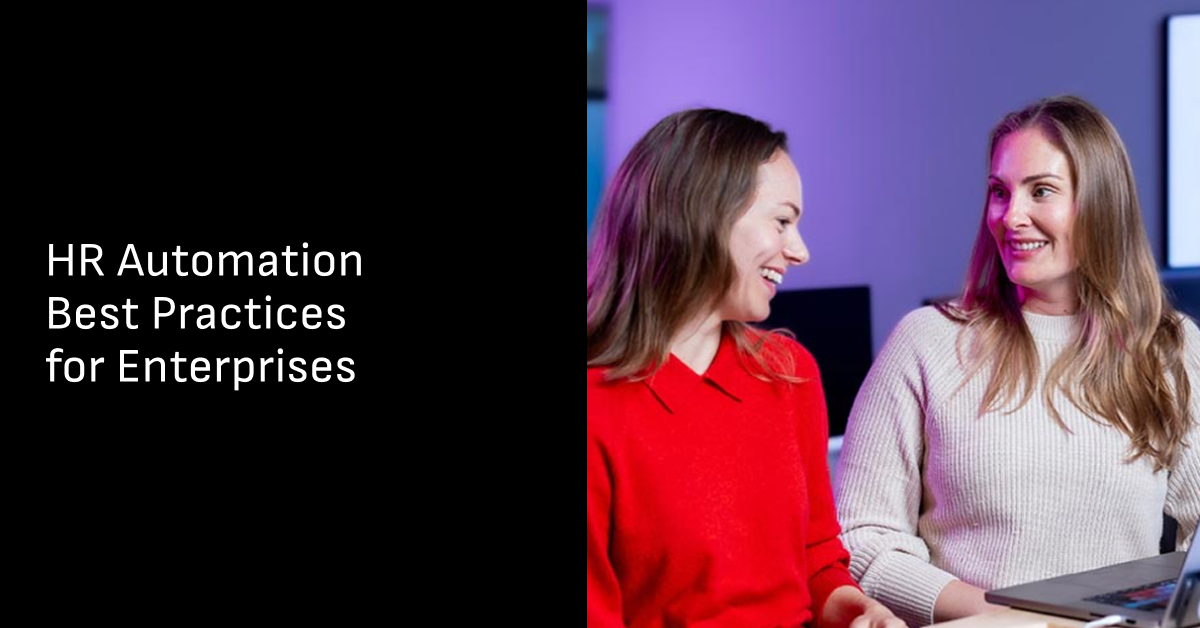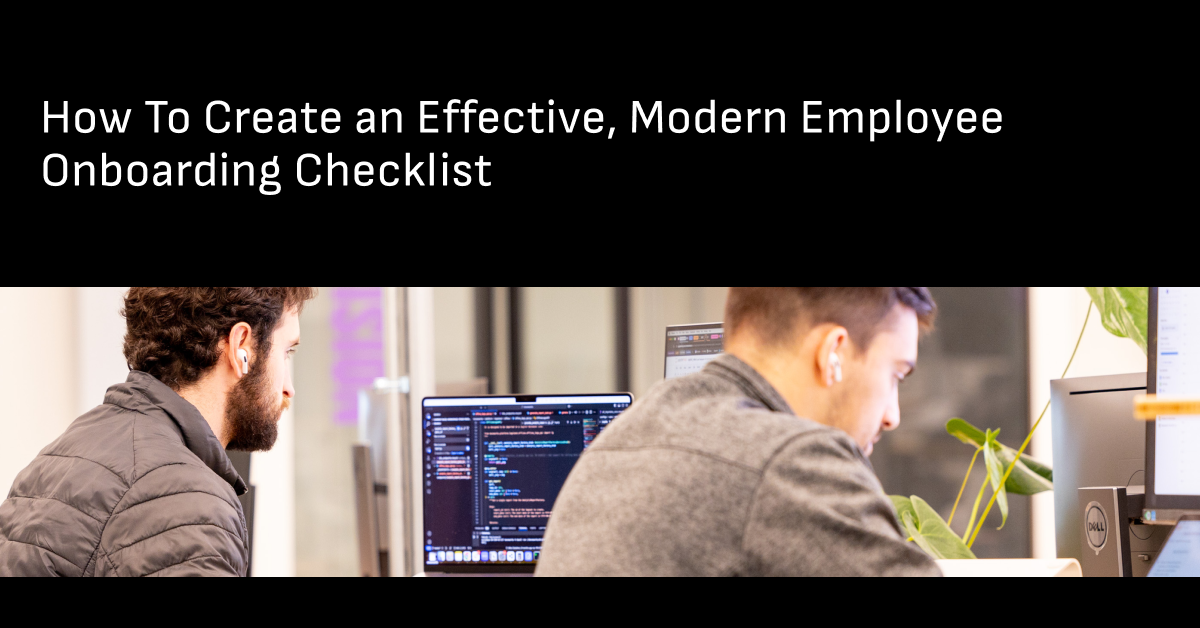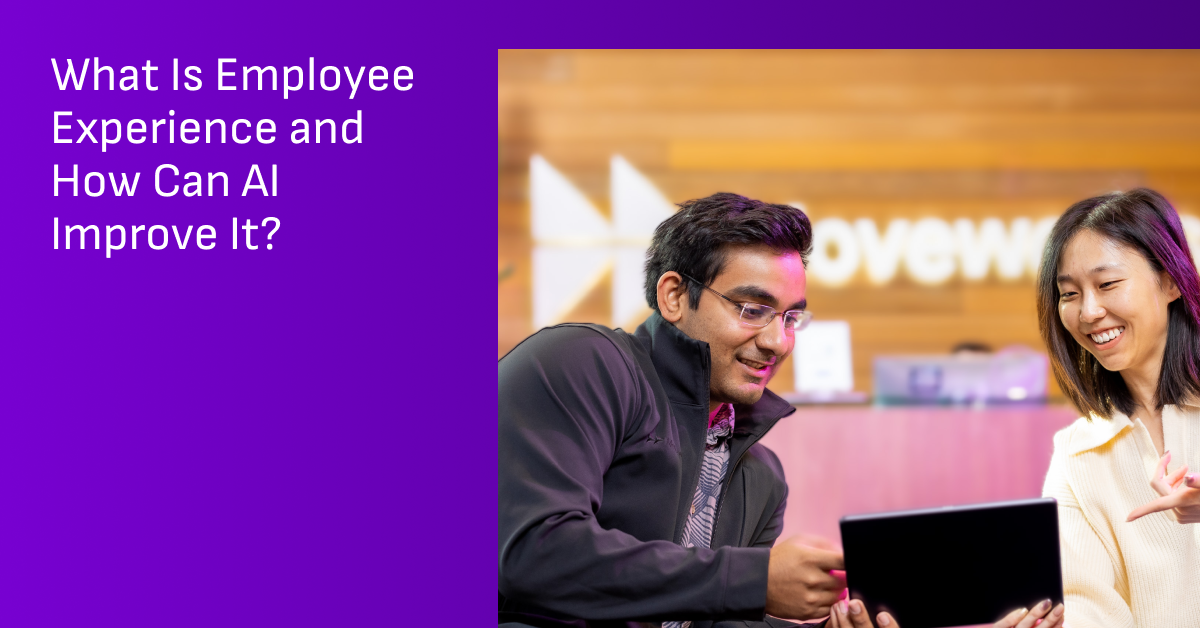Highlights
- HR efficiency drives business performance: Faster support, smoother onboarding, and optimized processes boost productivity and lower costs.
- Metrics highlight hidden friction points: Tracking indicators like time to hire or ticket resolution uncovers bottlenecks before they escalate.
- Top HR efficiency metrics provide focus: Key measures such as onboarding duration, ticket resolution time, automation coverage, and training completion rate give leaders a clear view of HR performance.
- Predictive analytics enables proactive workforce planning: Using historical data points helps forecast talent gaps, burnout risks, and future workforce needs.
- Automation enhances, not replaces, HR professionals’ judgment: AI improves speed and accuracy, but human oversight ensures that decisions stay people-first.
Manual processes. Siloed systems. Delayed responses. And an HR team stretched thin, switching between tools and chasing approvals, while employees grow frustrated and leaders ask, “Where’s the impact?”
For many HR leaders, this is an everyday reality—one that makes it tough to measure performance or prove value. That’s why it’s important to distinguish between efficiency and effectiveness. Efficiency is about speed. Effectiveness is about outcomes.
HR efficiency metrics connect the two, showing how everyday operations like onboarding, ticket resolution, and self-service shape business outcomes.
AI can transform how you collect and act on these key HR metrics. Instead of digging through multiple systems or waiting for quarterly reports, AI is able to capture data continuously, surfacs insights instantly, and can take action to improve efficiency.
What are HR efficiency metrics, and why are they essential for business success?
Think of HR efficiency metrics as the scorecard for measuring how smoothly your human resources department runs day-to-day. These key performance indicators (KPIs) measure how quickly, consistently, and cost-effectively HR delivers services across the employee journey—from onboarding new employees to processing leave requests, answering benefits questions, and resolving support tickets.
In short, they show what’s working, what’s lagging, and where employees might be hitting roadblocks.
But it’s helpful to delineate between efficiency and effectiveness:
- Efficiency = doing things right. It tracks speed, scalability, and resource utilization for HR processes, like time-to-hire, ticket resolution, and automation coverage.
- Effectiveness = doing the right things. This measures whether HR outcomes drive value, such as employee engagement, retention, or satisfaction.
Together, these measures give a comprehensive picture of HR’s impact, but efficiency is the foundation. Without it, HR leaders can’t spot bottlenecks, show ROI, or make the case for better tools.
Traditional reporting often makes tracking these metrics slow, error-prone, and retrospective. With AI, you can capture real-time efficiency data, gain continuous insights, and automatically improve processes.
How AI can transform HR metric tracking
Pulling HR metrics can feel like solving a puzzle with half the pieces missing. You’re digging through HR systems, ticketing apps, and chat threads just to piece together a report.
By the time it’s done, it may already be outdated, and your team has moved on to the next task. Manual reporting is slow, it’s error-prone, and it keeps HR leaders in constant “catch-up” mode.
AI makes tracking metrics easier and more accurate. Agentic AI can continuously gather data across onboarding systems, ticketing tools, self-service portals, and communication platforms, giving you a live pulse on what’s happening. AI dashboards turn that stream of data into clear visuals, surfacing trends, bottlenecks, and opportunities before they snowball.
Even better, repetitive tasks are automated, allowing your HR team to spend more time on higher-value work, like performance management or internal mobility. Instead of waiting weeks to react, you can identify issues in real time, take action faster, and steer outcomes that truly matter to employees and the business.
Key ways AI transforms metric tracking
AI does more than just collect data. It helps you see the story behind the numbers and act on it. Here’s how:
- Natural language understanding: AI can read support tickets, chat logs, and employee requests to identify the biggest pain points that are slowing people down. It’s like having a pulse on your team’s experience without asking them to complete another survey.
- Automated data analysis: Instead of tagging, categorizing, or sifting through thousands of interactions manually, AI does it instantly, highlighting trends, patterns, and anomalies you might otherwise miss.
- Personalized insights: Metrics aren’t one-size-fits-all. AI can segment data by role, team, or location, giving tailored insights and allowing you to benchmark against peers or industry standards.
- Proactive recommendations: Beyond the numbers, AI can suggest where to focus efforts, like automating PTO requests, and even act autonomously to improve metrics in real time.
- Strategic impact: For complex, global enterprises, this shift means HR leaders finally get a live view of efficiency across regions, systems, and touchpoints, and can act immediately to improve employee experience.
Check out our webinar on 5 Ways to Drive HR Efficiency Across the Employee Lifecycle with AI Agents for practical steps you can take today.
Top 10 HR efficiency metrics to track and how AI improves them
HR efficiency metrics are the KPIs that show how well your team handles core services and aligns with company goals, focusing on seamless, low-cost delivery.
As a quick reminder, these stand apart from effectiveness metrics: efficiency tracks the "how" of strong processes, while effectiveness measures the "what" of real-world results.
Here’s a snapshot of the most essential HR metrics and why they matter:
Metric | Definition | Why it matters |
Time-to-hire | Days from job posting to offer letter acceptance | Speeds up team building and keeps projects on track without empty seats |
Time to onboard | Number of days until new hires reach full productivity | Faster onboarding boosts engagement and retention |
Cost-to-hire | Total spend on recruitment, from job ads to interviews | Helps control budgets and lower hiring costs as you expand |
Employee self-service utilization | % of issues resolved without HR tickets | Lightens your team’s workload and gets employees answers fast |
HR ticket resolution time | Average time to resolve support requests | Faster resolution increases employee satisfaction and productivity |
First-contact resolution rate | % of inquiries resolved on first interaction | High rates = fewer follow-ups and more efficiency |
Training completion rate | % of employees completing required or optional training | Ensures compliance, upskilling, and development |
HR-to-employee ratio | Number of HR staff per total employees | Indicates scalability and staffing efficiency |
HR cost per employee | HR operating costs divided by total employees | Benchmarks resource use |
HR support team time savings | % of HR workflows handled with automation | Direct measure of scalability and modernization |
Recruitment
Recruitment metrics indicate how efficiently HR fills open roles and gets new hires up to speed. They uncover bottlenecks, highlight opportunities for improvement, and ensure the hiring process keeps pace with business growth.
1. Time-to-hire
What it measures: The number of days from posting a job to the candidate accepting an offer.
Why it matters: Long vacancies slow productivity, overburden other team members, and increase costs. The faster you hire, the sooner new employees contribute to your goals.
How AI helps: AI can automate candidate screening, schedule interviews instantly, and maintain timely communication with candidates, significantly reducing the time-to-hire without sacrificing candidate quality.
2. Time-to-onboard
What it measures: The time it takes for a new hire to become fully productive.
Why it matters: Efficient onboarding accelerates engagement, retention rate, and overall employee satisfaction. A clunky process can confuse or disengage new hires.
How AI helps: AI assistants streamline onboarding tasks, answer new hire questions on demand, while advanced agentic assistants canautomate provisioning, helping employees ramp up faster.
3. Cost-to-hire
What it measures: Total recruitment costs divided by the number of hires, including advertising, screening, and onboarding expenses.
Why it matters: Hiring costs can grow quickly for expanding teams. Monitoring this metric helps control spending and optimize hiring strategies.
How AI helps: AI improves candidate quality through advanced filtering and screening, reducing wasted effort and overall cost per hire.
Employee experience and support
These metrics reveal how well HR supports employees on a day-to-day basis. Efficient support means faster issue resolution, happier employees, and less manual work for your HR department.
4. Employee self-service utilization
What it measures: The percentage of HR issues employees resolve independently without submitting a ticket.
Why it matters: Higher self-service adoption reduces HR workload, speeds up responses, and empowers employees to get answers instantly.
How AI helps: AI-powered assistants guide employees to instant, personalized information, increasing adoption and reducing repetitive requests.
5. HR ticket resolution time
What it measures: The average time it takes to resolve HR support requests.
Why it matters: Slow resolution can frustrate employees, lower satisfaction, and hurt productivity.
How AI helps: AI automates routine tasks and common requests, helping HR resolve tickets faster while keeping employees informed along the way.
6. First-contact resolution rate
What it measures: The percentage of inquiries resolved on the first interaction.
Why it matters: Higher first-contact resolution means fewer follow-ups, less frustration, and more efficient HR operations.
How AI helps: With context-aware responses, AI assistants are able to resolve many requests instantly—no extra steps required.
Development and performance
These metrics show how efficiently HR supports employee growth and organizational scalability. They ensure that training, staffing, and resources align with business goals.
7. Training completion rate
What it measures: The percentage of employees who complete required or optional training within set deadlines.
Why it matters: Ensures that compliance, upskilling, and development goals are met efficiently, supporting business growth.
How AI helps: AI can send automated reminders, track completions in real time, and flag gaps, helping keep training programs on schedule without requiring repeated manual follow-up.
8. HR-to-employee ratio
What it measures: How many HR staff members are supporting the workforce.
Why it matters: Indicates staffing efficiency and scalability. Lower ratios (without sacrificing quality) suggest streamlined processes.
How AI helps: Agentic AI can scale support globally, handling repetitive and context-driven requests, allowing HR to support more employees without expanding headcount.
9. HR cost per employee
What it measures: Total HR operating costs divided by the total number of employees.
Why it matters: Provides a benchmark for efficiency and resource use, helping leaders manage budgets effectively.
How AI helps: Automation reduces the cost-to-serve while maintaining service quality, freeing up resources for strategic HR initiatives.
10. HR support team time savings
What it measures: The percentage of HR workflows handled by automation versus manually.
Why it matters: Directly measures scalability and modernization; more automation means HR can focus on higher-value work.
How AI helps: Agentic AI handles routine tasks as well as context-heavy requests, unlocking significant time savings for HR teams.
Other key metrics to consider
Beyond these top 10, HR leaders also track metrics like offer acceptance rate, applicant source quality, and diversity in the pipeline to evaluate recruiting efficiency. Interview-to-hire ratio signals screening quality, while new hire satisfaction provides a critical check on onboarding. Training investment per employee and internal mobility rate measure how well HR supports growth and retention.
How to turn HR insights into strategic action
Capturing HR efficiency metrics is important, but the real value lies in translating those numbers into action.
Metrics alone won’t move the needle. What matters is how you use them to improve employee experience, streamline processes, and demonstrate the impact of HR on business outcomes. Here’s how to turn insights into progress:
Step 1: Analyze trends and spot bottlenecks with context
Look at metrics like case resolution time or onboarding duration to identify areas where processes slow down.
But don’t stop with the numbers: Pair them with employee feedback to uncover the real causes behind the delays. That’s how you move from data to meaningful action. For instance, if tickets pile up around benefits, the real issue might be unclear guides.
Step 2: Benchmark and set realistic goals
Combine internal baselines (your historical data) with external benchmarks (industry standards) to measure progress. The key is to not try to fix everything at once. Pick one or two areas where improvements will have the biggest impact. Shaving days off time-to-hire, for example, could save thousands in lost productivity.
Step 3: Tie actions to business outcomes
Translate efficiency wins into results that matter to executives. Faster PTO approvals build employee trust. Shorter onboarding frees managers to focus on strategy. Framing improvements this way makes it clear that HR is driving business value, not just fixing processes.
Step 4: Leverage agentic AI to close the loop
Agentic AI assistants answer questionsand can act to resolve them too. They can automate routine HR requests, flag trends in real time, and identify process bottlenecks creating a cycle of continuous improvement instead of waiting for quarterly or annual reports.
By acting on HR insights, leaders elevate HR from a reactive support function to a proactive driver of engagement, productivity, and business growth.
Moveworks helps HR leaders push past flat reports to spark true shifts. With Employee Experience Insights, you see exactly where holdups occur—from lagging tickets to onboarding snags to underused self-service.
With agentic AI at its core, our platform goes beyond diagnosing issues. It resolves common requests on its own, suggests process improvements, and extends support seamlessly across platforms like Workday, Slack, and Microsoft Teams.
How Moveworks helps enterprises measure and improve HR efficiency
Tracking metrics is only the first step. Transforming them into meaningful results is where Moveworks makes the difference. With agentic AI, automation, and personalized support, HR leaders can move faster, scale smarter, and deliver the seamless experience employees expect. Here’s how:
- See the big picture in real time: Moveworks aggregates data across all HR systems and communication tools, giving you a unified view of employee experience. You can catch issues before they escalate and track support quality across regions, teams, and business units. The platform surfaces the most relevant HR articles and policies instantly, helping reduce search time and duplicate requests.
- Turn dashboards into action: Instead of surface-level reports, Moveworks highlights hidden gaps, benchmarks performance, and delivers recommendations you can act on today.
- Automate the work that slows you down: From leave requests to FAQs, Moveworks handles repetitive tasks instantly. That means shorter queues, fewer delays, and more capacity for your team to focus on strategic initiatives—while also orchestrating HR approvals for items like time off and timesheets, routing them to the right approver with full context to reduce cycle times.
- Give every employee personalized, instant support: Employees want fast answers, not a maze of systems. Moveworks delivers tailored onboarding, knowledge, and HR support in the preferred language and channel of each user, including Slack, Microsoft Teams, and Workday. It tailors responses to role, location, and policy context, so employees get accurate answers the first time.
With Moveworks, you don’t just measure HR efficiency—you improve it. Cutting down manual reporting and resolving requests faster allows HR teams to focus on proactive leadership instead of firefighting. Moveworks analytics show what employees ask for most, where friction exists, and how sentiment shifts, so HR can fix the processes and content that make the biggest impact.
Explore AI for HR with Moveworks today and transform data into decisions that drive your enterprise forward.
Frequently Asked Questions
When HR operates efficiently, employees get faster support, onboarding runs smoothly, and resources are used wisely. This ripple effect boosts productivity, reduces costs, and helps the business adapt quickly to change.
Efficiency metrics reveal how quickly and effectively HR responds to employee needs. Faster support, smoother onboarding, and proactive engagement show employees they’re valued, which directly strengthens satisfaction and reduces turnover.
Predictive analytics takes past HR data and forecasts what’s ahead, like talent shortages or burnout risks. This allows HR leaders to act early, shifting the function from reactive problem-solving to proactive workforce planning.
Efficiency metrics measure how quickly and efficiently HR processes are. HR analytics goes deeper, uncovering the why by looking at patterns, correlations, and root causes behind performance outcomes.
Automation works best when it enhances human decision-making. The risk lies in automating without regular oversight. Leading HR teams blend AI-driven insights with strategic, people-first leadership to strike the right balance.
The most critical HR efficiency metrics include time-to-hire, time-to-onboard, HR ticket resolution time, first-contact resolution rate, employee self-service utilization, PTO and leave request processing time, training completion rate, HR-to-employee ratio, HR cost per employee, and automation coverage percentage. Together, these metrics provide a complete view of how efficiently HR operates.
Measuring HR efficiency at scale requires consistent metrics and localized insights. AI assistants help by aggregating data across regions, languages, and platforms, giving leaders a unified global view while adapting to local employee needs.
Table of contents



